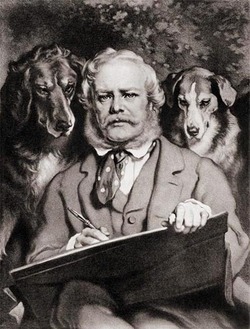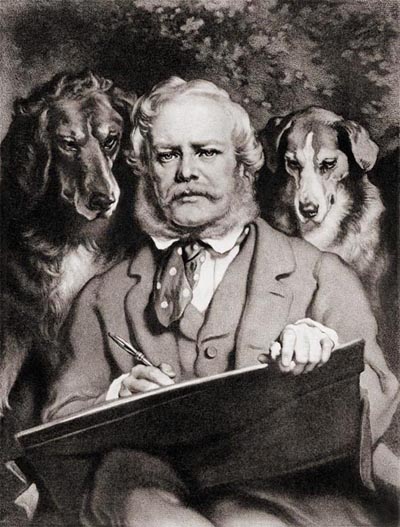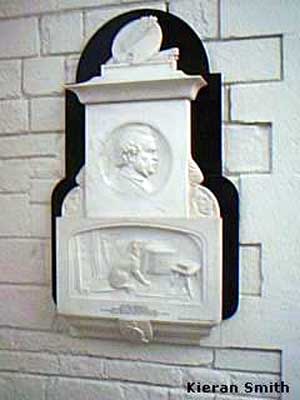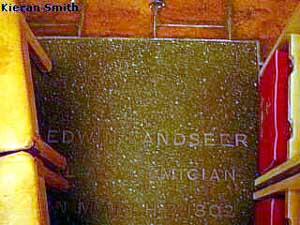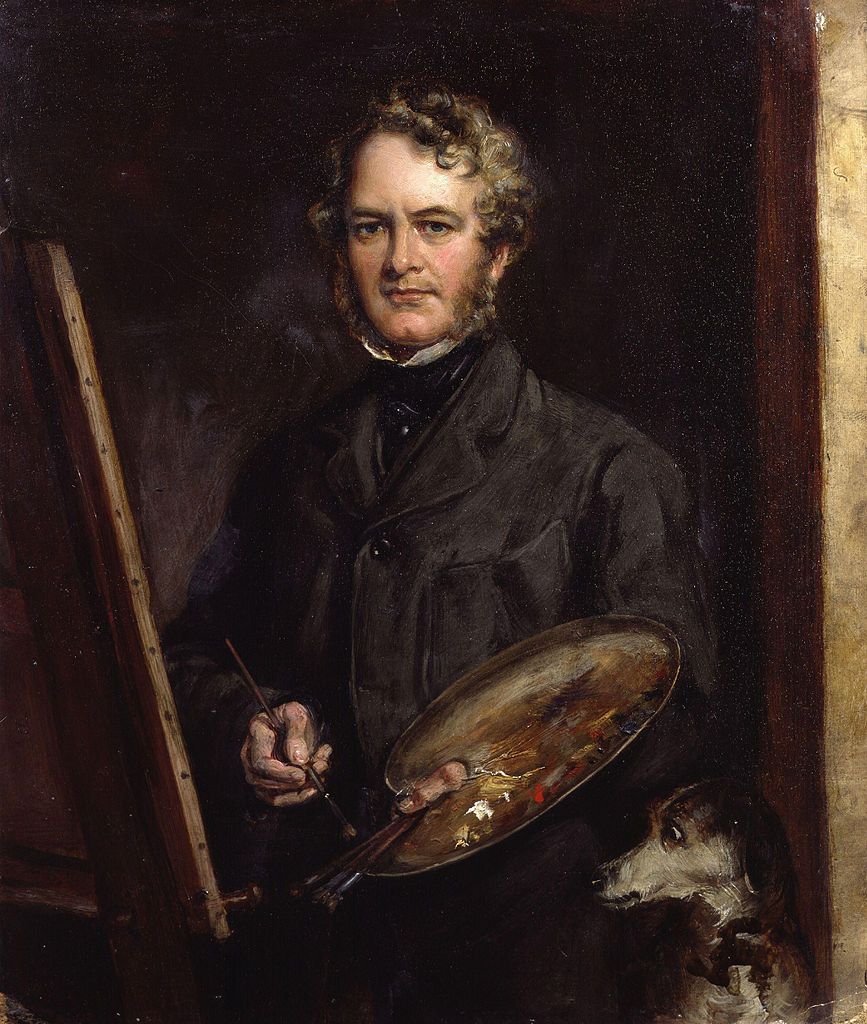Painter, Sculptor. He gained fame as an English artist who could capture the beauty of dogs, including Queen Victoria's pets. He created portraits of fellow Britons, including ones of Prince Albert and Queen Victoria, who knighted him in 1850. Born the youngest son of the Royal engraver John Landseer, he was something of a prodigy whose artistic talents were recognized early. He studied under several artists, including his father and the historical painter Benjamin Robert Haydon, who encouraged him as a youngster to perform dissections of animals in order to fully understand musculature and skeletal structure. His early career was entwined with the Royal Academy, as he exhibited a piece informally at age nine, received the Royal Society of Arts' silver palette for his animal drawings at age 11, and at the age of 13, in 1815, formally exhibited works at the academy. He was renowned for his paintings of horses and dogs. His dog paintings of the 1830′s are by far his most popular, with "Dignity and Impudence" of 1839 being the most famous of all. Although known for painting a host of animals, he was best known for his paintings of the Newfoundland breed of dogs. He was elected an Associate of the Royal Academy at the age of 24 and an Academician five years later in 1831. Included in his artistic achievements are the lion sculptures in Trafalgar Square in London. In 1858, the government commissioned him to create four bronze lions for the base of Lord Nelson's Column in Trafalgar Square, following the rejection of a set-in-stone by well-known animal sculptor Thomas Milnes. Not known as a sculptor, he accepted on the condition he would not have to start work for another nine months, and there was a further delay when he asked to be supplied with copies of casts of a real lion he knew were in the possession of the Academy at Turin. The request proved complex since the cast did not arrive from Italy until the summer of 1860. The lions were made at the Kensington studio of Turin-born sculptor Carlo Marochetti, who also cast them. Work was slowed by his ill health and his fractious relationship with Marochetti. The sculptures were installed in 1867, showing gigantic sphinx-like cats measuring 20 feet long, 11 feet high, and weighing seven tons. He became a wealthy bachelor. In the late 1830s, he suffered a mental breakdown and, for the rest of his life, was troubled by recurring bouts of melancholy, hypochondria, and depression, often aggravated by alcohol and drug use. In the last three and half years of his life, his mental instability was problematic, with his talented hand and brain becoming increasingly feeble, and at the request of his family, he was declared insane in July of 1872. He died 14 months later. To name a few locations, his paintings are exhibited at the Tate Museum in London, the Royal Trust, and the National Galleries of Scotland, as well as in the United States at the Smithsonian Art Museum in Washington D.C., J. Paul Getty Museum in Los Angeles, and the Metropolitan in New York City.
Painter, Sculptor. He gained fame as an English artist who could capture the beauty of dogs, including Queen Victoria's pets. He created portraits of fellow Britons, including ones of Prince Albert and Queen Victoria, who knighted him in 1850. Born the youngest son of the Royal engraver John Landseer, he was something of a prodigy whose artistic talents were recognized early. He studied under several artists, including his father and the historical painter Benjamin Robert Haydon, who encouraged him as a youngster to perform dissections of animals in order to fully understand musculature and skeletal structure. His early career was entwined with the Royal Academy, as he exhibited a piece informally at age nine, received the Royal Society of Arts' silver palette for his animal drawings at age 11, and at the age of 13, in 1815, formally exhibited works at the academy. He was renowned for his paintings of horses and dogs. His dog paintings of the 1830′s are by far his most popular, with "Dignity and Impudence" of 1839 being the most famous of all. Although known for painting a host of animals, he was best known for his paintings of the Newfoundland breed of dogs. He was elected an Associate of the Royal Academy at the age of 24 and an Academician five years later in 1831. Included in his artistic achievements are the lion sculptures in Trafalgar Square in London. In 1858, the government commissioned him to create four bronze lions for the base of Lord Nelson's Column in Trafalgar Square, following the rejection of a set-in-stone by well-known animal sculptor Thomas Milnes. Not known as a sculptor, he accepted on the condition he would not have to start work for another nine months, and there was a further delay when he asked to be supplied with copies of casts of a real lion he knew were in the possession of the Academy at Turin. The request proved complex since the cast did not arrive from Italy until the summer of 1860. The lions were made at the Kensington studio of Turin-born sculptor Carlo Marochetti, who also cast them. Work was slowed by his ill health and his fractious relationship with Marochetti. The sculptures were installed in 1867, showing gigantic sphinx-like cats measuring 20 feet long, 11 feet high, and weighing seven tons. He became a wealthy bachelor. In the late 1830s, he suffered a mental breakdown and, for the rest of his life, was troubled by recurring bouts of melancholy, hypochondria, and depression, often aggravated by alcohol and drug use. In the last three and half years of his life, his mental instability was problematic, with his talented hand and brain becoming increasingly feeble, and at the request of his family, he was declared insane in July of 1872. He died 14 months later. To name a few locations, his paintings are exhibited at the Tate Museum in London, the Royal Trust, and the National Galleries of Scotland, as well as in the United States at the Smithsonian Art Museum in Washington D.C., J. Paul Getty Museum in Los Angeles, and the Metropolitan in New York City.
Bio by: Linda Davis
Family Members
Advertisement
See more Landseer memorials in:
Advertisement
